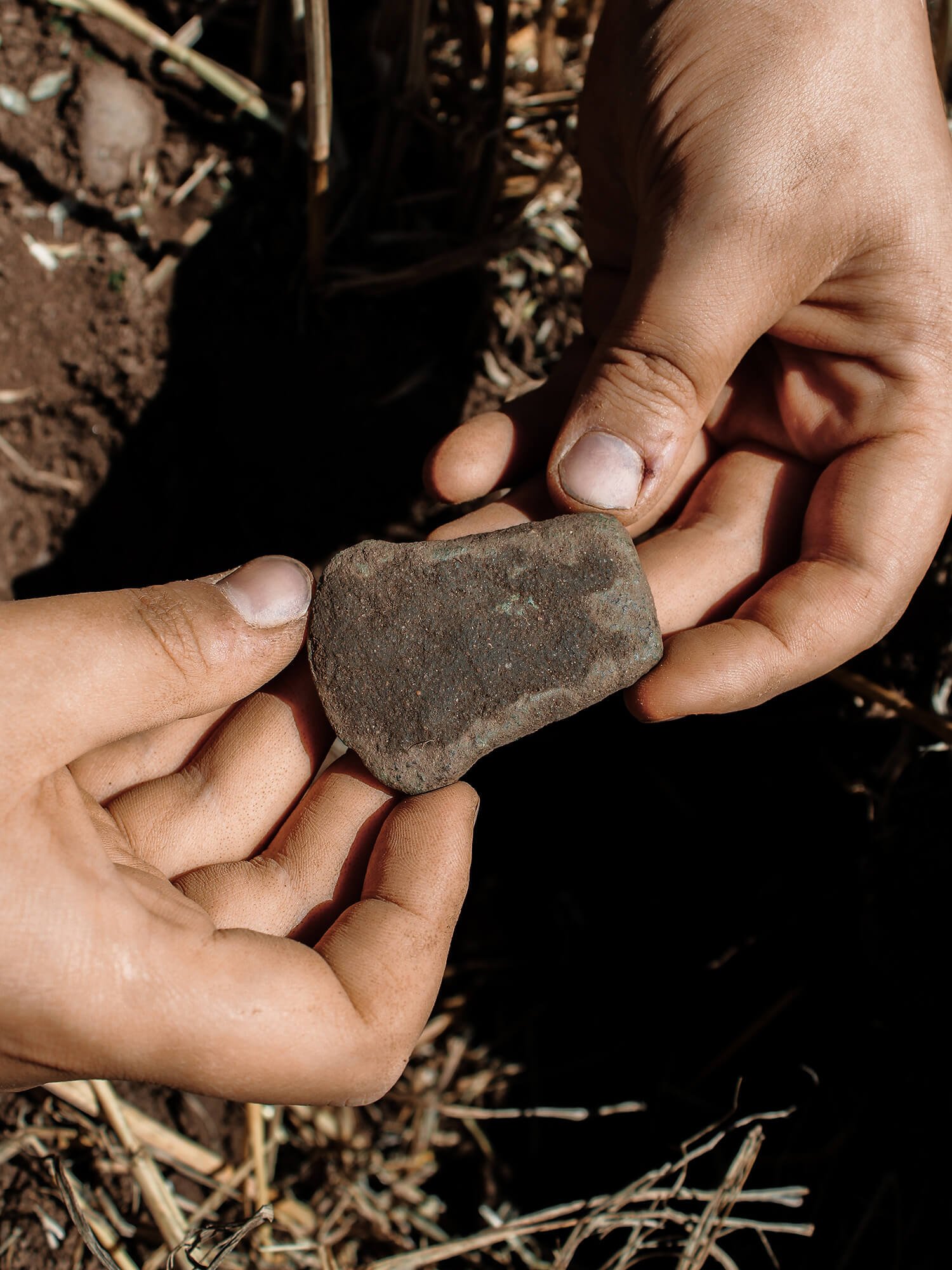BRONZE AGE: FLAT AXE
PERIOD: BRONZE AGE LOCATION: LINCOLNSHIRE, UK MATERIAL: BRONZE / COPPER ALLOY
A day that we certainly won’t be forgetting for a long time.
Welcomed onto a brand new permission, given a rather large wheat stubble field to play in and invited back for lunch with the promise of something old to show for it, we never in a million years would have guessed we would be returning with something Bronze Age. Our oldest ever discovery to date.
It certainly wasn’t looking like a very prosperous day either, an hour after setting foot into the field, as signal after signal after depressing signal was either a Diet Coke can or a large melted indescribable lump of aluminium or lead. But we stuck it out and kept digging those high 20’s on the VDI because as we kept saying ‘You just never know!’. Wandering over towards a large wooded area that bordered the edge of the field we were treated with our first find in the form of a lost aluminium dog tag. Better than a Diet Coke can, which the following signal turned out to be. Yet another strong high 20’s popped up as we continued towards the woods and Lucie turned “There you go another Diet Coke can for you!”. Imagine our shock as a Bronze Age Axe appeared instead.
Yet another strong high 20’s popped up as we continued towards the woods and Lucie turned “There you go another Diet Coke can for you!”.
The idea of finding something from Prehistory, the era of human history that we know the least about and can only learn through its artefact remnants, has always blown our minds and remained the top post on the bucket list for a very long time. As a metal detectorist the oldest thing that you can find in Britain is the Bronze Age, the era when metal was introduced for the very first time by travellers and settlers from Europe, and it doesn’t come about often.
The axe especially is one of the oldest tools used by mankind and it was the essential tool of the Bronze Age. Despite the time period being named after the introduction and use of Bronze, the main technology used at the time, it can be argued that wood was probably the most important material to the Bronze Age people. The Bronze Axe was just a better and more efficient means to acquire this important material than its stone predecessor.
Wood to a Bronze Age person was such an important resource. One used for fuel to create light and heat as well as in the construction and fabrication of practically every atom existing in the Bronze Age. From buildings to fences to boats to furniture to even the metal tools they were casting wood was a necessity. It was the foundation of Bronze Age technology. Metal ores could not be smelted without a fire and a fire could not be created without wood, only a charcoal fire was able to attain the high enough temperatures required to smelt the ores ready for casting, and once casted every axe needed a wooden handle to allow it to be used. The axe and the wood it chopped down were almost an endless circle, each requiring the other to be used.
As a metal detectorist the oldest thing that you can find in Britain is the Bronze Age, the era when metal was introduced for the very first time by travellers and settlers from Europe, and it doesn’t come about often.
There are three main types of Bronze Age Axe that can be found, the flat axe, the palstave axe and the socketed axe. Of the three the flat axe is the earliest type that can be found and copper flat axes in particular are the earliest type of metal axe that can be found in Britain from even before they created bronze. The axe that Ellie is clutching in her hands in disbelief over the hole from our latest ‘Diet Coke Signal’ turns out to be none other than a very early Bronze Age Flat Axe from the Flat Axe / Flanged Axe transition phase making it around 4,000 - 5,000 years old and possibly the oldest artefact that we could ever find.
To produce axes of this type the Bronze Age people developed casting techniques using simple one - piece moulds that they carved out of sedimentary rocks such as sandstone and soapstone. These materials were soft and easy to carve but could also withstand the great temperatures required during the casting process. Once the molten metal was poured into the moulds each axe required a lot of following work to harden, sharpen, finalise the shape and fix into a wooden handle known as a haft for use.
At the very introduction of this technology metal axes were treated as special objects and it is common to find bronze age axes buried in large hoards that could be attributed as offerings to the gods. As the most important tool to their life at the time it does make sense that they became almost a form of currency and votive object that had a variety of uses, not just for felling trees. In fact small votive axes have been found across the country by metal detectorists that it is believed were created as talismans and symbols, worn and then made as offerings to the gods. These votive axes are also often found in Iron Age and Early Roman contexts showing the overlap of beliefs and periods and how incredibly important the axe symbol was to the way of life at the time. Maybe a votive Bronze Age axe will have to take the top place on the Roman Found bucket list from here on?




